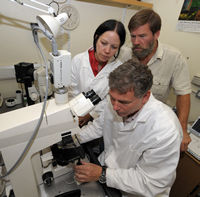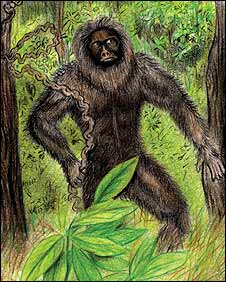
July 24, 2008

Technician John Wells looks at the hairs through a microscope as Anna Nakaris, anthropolgist, and Ian Redmond, primatologist, look on.
The hunt for the mysterious Yeti – otherwise known as the Abominable Snowman – has frustrated scientists for decades.
Yesterday, scientists at Oxford Brookes University joined in the hunt after being given a number of hair strands taken from what is purported to be a Yeti-like creature in India.
The Brookes boffins used high-powered microscopes to analyse the samples found in the West Garo jungle of the north-eastern state of Meghalaya.
They compared the suspected Yeti strands to samples taken from primates, bears, dogs, yaks and humans, which were provided by the Natural History Museum in Oxford.
After the microscope tests have been carried out, the hairs will be sent away to a laboratory for DNA testing.
Dr Anna Nekaris, of the university’s anthropology department, said: “It’s exciting to be asked to take part in this research.
“We put the hairs in clear nail varnish because that helps us to see them more clearly under the microscope.
“Hair cuticle patterns differ greatly from species to species when you look at them under a microscope.

An artist’s impression of the beast
“If we look closely at the specimens we have from the alleged Yeti we can see if they are identical to a primate or a dog or a bear.
“If it is a primate we can’t identify, then that would be an interesting first step.”
Dr Nekaris was joined by leading primatologist Ian Redmond OBE, whose book The Primate Family Tree is out later this year.
He said: “If these hairs do turn out to come from a Yeti then I will have to quickly update my book.
“Recently a new species of macaque monkey was discovered in India and new species of primates are being discovered every year.
“It may be that the region this animal is inhabiting is remote enough for it to remain undiscovered so far.”
The little known Indian version of the legendary ape-like creature is called mande barung – or forest man – and the black and grey animal is thought to stand about 10ft tall.
The hair was discovered earlier this year by BBC reporter Alastair Lawson, who went on an expedition to find the animal after a number of reported sightings.
A forestry officer had seen the creature in the same location and gathered the hair from the area where it had been standing.
Mr Lawson brought the hair back to England to be analysed and contacted Mr Redmond, who then linked up with scientists at Oxford Brookes.
Mr Lawson said: “The forestry officer said he had seen the Yeti two days in a row and persuaded a zoologist to come with him to collect the hairs.
“I’m not convinced that the Yeti exists, but we might have come across a primate that has not been discovered before.
“You have to bear in mind that the legend of the Yeti is a large part of the people’s culture in this region and those traditions are deeply respected.
“The Gaza correspondent Alan Johnston was once given hairs in Pakistan which were thought to have been taken from a Yeti and they turned out to be hairs from a goat’s scrotum.”
About the Yeti The Yeti is an apelike animal said to inhabit the Himalaya region of Nepal and Tibet.
The scientific community has largely dismissed the Yeti as a fraud but it remains one of the most famous creatures of cryptozoology, the study of uncomfirmed animals.
The Yeti was dubbed the Abominable Snowman in 1921 after an Everest expedition found large footprints at 21,000ft. Sir Edmund Hillary also reported large footprints on Everest in 1953.
In December last year, American TV presenter John Gates reported finding 33cm-long footprints in the Everest region of Nepal.
Bigfoot, sometimes known as Sasquatch, is an alleged ape-like creature said to inhabit the Pacific northwest region of the United States and the Canadian province of British Columbia.
Alleged witnesses have described large eyes, a pronounced brow ridge, and a large, low-set forehead.
Source: “‘Yeti hairs’ examined,” by Andrew Ffrench, Oxford Mail, July 24, 2008.
About Loren Coleman
Loren Coleman is one of the world’s leading cryptozoologists, some say “the” leading living cryptozoologist. Certainly, he is acknowledged as the current living American researcher and writer who has most popularized cryptozoology in the late 20th and early 21st centuries.
Starting his fieldwork and investigations in 1960, after traveling and trekking extensively in pursuit of cryptozoological mysteries, Coleman began writing to share his experiences in 1969. An honorary member of Ivan T. Sanderson’s Society for the Investigation of the Unexplained in the 1970s, Coleman has been bestowed with similar honorary memberships of the North Idaho College Cryptozoology Club in 1983, and in subsequent years, that of the British Columbia Scientific Cryptozoology Club, CryptoSafari International, and other international organizations. He was also a Life Member and Benefactor of the International Society of Cryptozoology (now-defunct).
Loren Coleman’s daily blog, as a member of the Cryptomundo Team, served as an ongoing avenue of communication for the ever-growing body of cryptozoo news from 2005 through 2013. He returned as an infrequent contributor beginning Halloween week of 2015.
Coleman is the founder in 2003, and current director of the International Cryptozoology Museum in Portland, Maine.
Filed under Abominable Snowman, Breaking News, Cryptotourism, CryptoZoo News, Cryptozoologists, Cryptozoology, Eyewitness Accounts, Forensic Science, Yeti